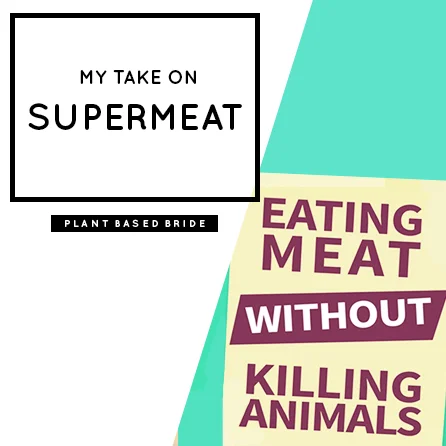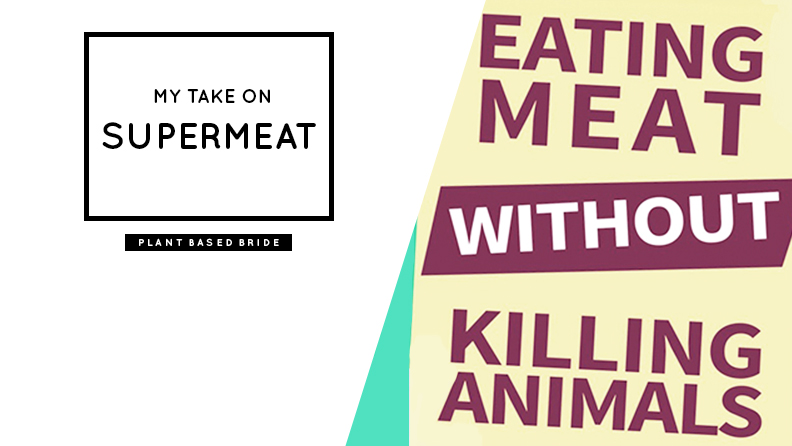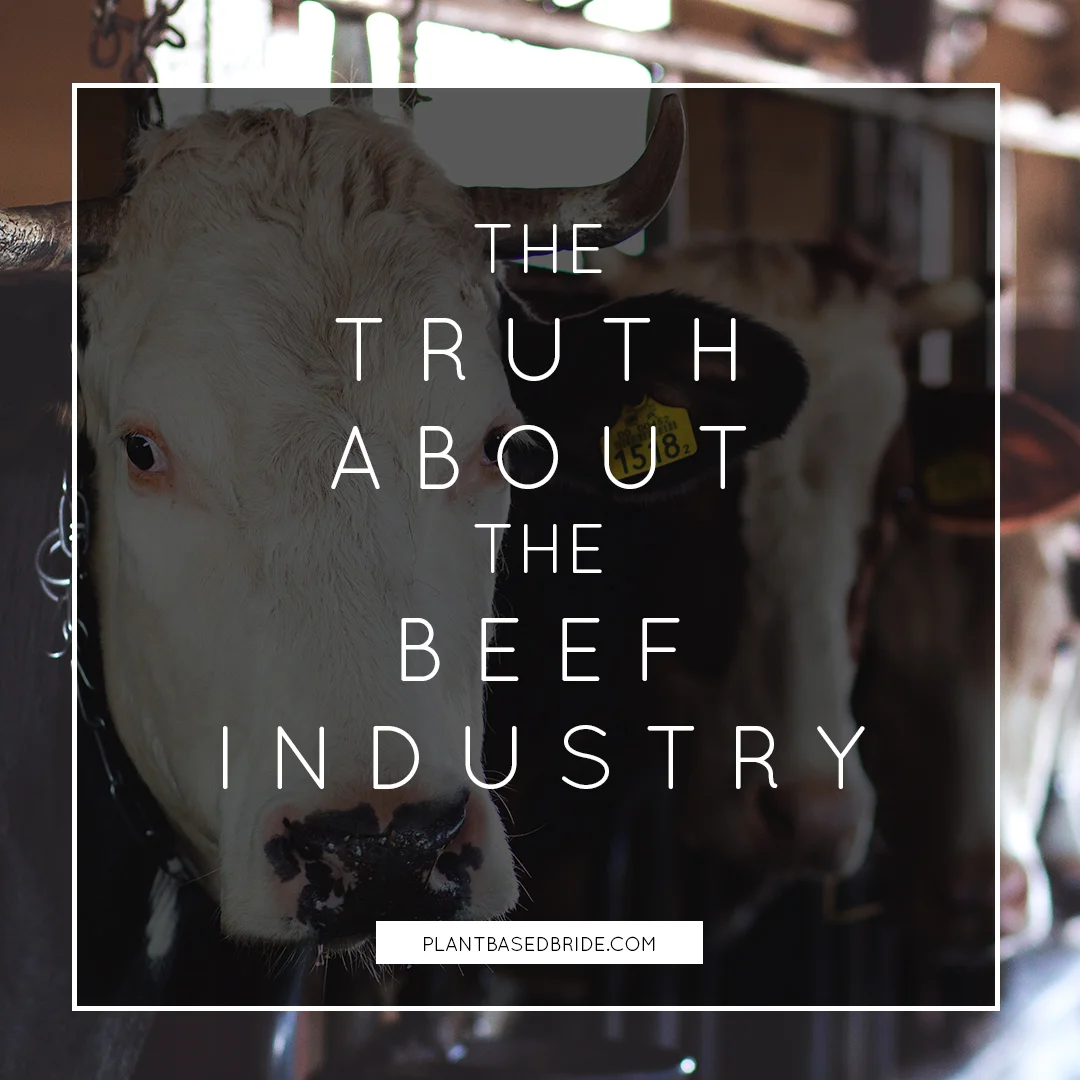
the blog.
SuperMeat
SuperMeat. Cultured meat grown from real cells. What kind of impact will it have on the vegan movement and the planet at large? Let's chat.
SuperMeat. Cultured meat grown from real cells. What kind of impact will it have on the vegan movement and the planet at large? Let's chat.
Watch here or on YouTube, and don't forget to subscribe to my channel for new videos every Monday and Saturday!
What are your thoughts on SuperMeat? Would you eat it? Let me know in the comments below!
Until next time,
What Is Sentience?
Sentience. A term, just like cognitive dissonance, oft-used yet seldom understood. Today we go deep into the true meaning of sentience and its impact on our perception and treatment of animals.
Sentience. A term, just like cognitive dissonance, oft-used yet seldom understood. Today we go deep into the true meaning of sentience and its impact on our perception and treatment of animals.
SENTIENT
- responsive to or conscious of sense impressions <sentient beings>
- aware
- finely sensitive in perception or feeling
Or in simpler terms, sentient being are able to feel, see, hear, smell, or taste. Sentience refers to a being's ability to experience and perceive these sensations.
The term Sentience was first used by philosophers in the 1700s to make a distinction between a being's ability to think (reason) and feel (sentience).
Many eastern religions recognize non-human animals as sentient, such as Buddhism and Jainism. This is largely due to their understanding of ahimsa, which refers to a commitment to nonviolence towards all other beings. Many yogis will be familiar with this concept, as it is the first (and arguably most important) yama described in the Yoga Sutra.
Are Animals Sentient?
In a word, yes. By the widely held definition of the term, non-human animals are sentient.
A cow can feel, see, hear, smell, and taste.
So can a pig.
And a cat. And a lamb.
And a dog. And a chicken.
Not only can they do that, but they can feel pain and pleasure.
This is a non-disputed fact. You know from first-hand experience that your cat or dog or other household companion feels pain and pleasure. And we know from observation and other forms of scientific enquiry that all other animals do as well.
This is a basic tenant of the animal rights movement. It is held that as sentient beings capable of suffering, non-human animals are entitled to protection from that very suffering.
The following quote from Jeremy Bentham, an 18th-century philosopher, encompasses the logic quite well:
The French have already discovered that the blackness of the skin is no reason why a human being should be abandoned without redress to the caprice of a tormentor... What else is it that should trace the insuperable line? Is it the faculty of reason, or, perhaps, the faculty of discourse? But a full-grown horse or dog is beyond comparison a more rational, as well as a more conversable animal, than an infant of a day, or a week, or even a month, old. But suppose the case were otherwise, what would it avail? The question is not Can they reason? nor, Can they talk? but, Can they suffer?
A simple example?
If you scratch a table with your keys, the table will not suffer. But if you cut into a cow's skin? You better bet he's going to feel pain.
Need further proof? In 2012 an international panel of neuroscientists came together to sign the Cambridge Declaration on Consciousness, stating that humans are not unique in having consciousness as many animals including "all mammals and birds, and many other creatures, including octopuses" also posses the neurological substrates allowing them to possess a consciousness.
Humans are not alone in our ability to feel pain and pleasure, to see, to hear, to taste, to touch, and to smell. This is known.
Chimpanzees understand and exhibit fairness.
Cows form life-long friendships and feel stressed when they are separated.
We know these things. And yet, as a society, we avoid declaring animal sentience.
Perhaps we are afraid to acknowledge that we have been systematically torturing and killing billions of sentient beings for centuries.
Or perhaps, even more damaging to our fragile human ego, we are afraid to come to terms with the truth - that we are far more similar to other species than we like to think.
What is your take on animal sentience? Weigh in in the comments.
Until next time,
The Truth About The Beef Industry
Unlike most animal foods, many people are not only aware of the negative impact of eating beef on their health but actively avoiding it - and they're right to.
But it's not just for health reasons that beef is a bad choice. The raising of cattle has more of an environmental impact than you might realize, and is definitely no fun for the cows.
Let's explore the truth behind the beef industry.
Unlike most animal foods, many people are not only aware of the negative impact of eating beef on their health but actively avoiding it - and they're right to.
But it's not just for health reasons that beef is a bad choice. The raising of cattle has more of an environmental impact than you might realize, and is definitely no fun for the cows.
Let's explore the truth behind the beef industry.
HEALTH
For a long time beef was seen as a 'super food', and I can understand the thought process, however misguided. Not only is beef a concentrated source of calories (which we were in dire need of for the majority of the centuries we have existed on earth) and high in protein, which we all know is the most important macronutrient. Or is it?
The Real Rundown On Protein
Dr. Garth Davis does an incredible job of debunking the protein myths in his book Proteinaholic, and I would highly suggest giving it a read for more in depth information. In the meantime, let me summarize some of the points that stood out to me the most:
You Don't Need As Much Protein As You Think
While it is true that protein is essential for human health, we don’t need nearly as much of it as we think we do. The World Health Organization published a technical report in 2002 titled Protein and Amino Acid Requirements in Human Nutrition in which they concluded that the average healthy adult of either gender requires a minimum of 0.66g of protein per day per kg of lean body weight. For example, a 150lb (68kg) person would need 44.9g of protein per day to meet the minimum of their daily protein needs - IF they had no fat on their body (not likely). They also recommend adding a buffer to guarantee "safe levels" of protein intake per day, which brings their daily recommendation up to 0.83g per kg of lean body weight. This would translate to the same 150lb (68kg) person requiring 56.4g of protein per day (once again, if they had no fat on their body. It is far more likely that their lean body mass would fall in the range of 90 to 130 lbs or approximately 41 to 59 kg. This person would actually only require 34 to 49g of protein a day, even at the higher protein recommendation.)
Surely, though, more is better? We certainly don’t want to be deficient in this important macronutrient. Dr Garth Davis hit the nail on the head when he said: “In all my years in medicine I have never, ever, seen a patient who was suffering from protein deficiency. I have searched the medical literature and cannot find a single case of protein deficiency in someone eating adequate calories.” In other words, if you are eating enough calories, you will get enough protein.
But what if we want to be on the safe side? Get just a little bit extra? That’s not really a good idea. Unlike fat and carbohydrates, the body doesn’t have a storage system for excess protein. It will instead be converted into fat or broken down into potentially toxic nitrogen components.
Animal Protein Isn't Actually Superior To Plant Protein
You may have heard of essential amino acids. These are the 9 amino acids the human body cannot create on its own, meaning they must be ingested on a regular basis. These nine essential amino acids are:
- histidine
- isoleucine
- leucine
- lysine
- methionine
- phenylalanine
- threonine
- tryptophan, and
- valine
You may have also heard that plant protein is not ideal as each individual type of plant does not contain all of the essential amino acids. This is what lead to the ‘complete protein’ craze. As meat and dairy products contain all nine, they were seen as superior sources of protein. However, it has been proven time and time again that not only do plants in their vast variety contain all of the nine essential amino acids, but that all nine do not need to be ingested at the same meal for our bodies to utilize them and synthesize important proteins. So while eating rice with beans is delicious, you needn’t eat them at the same time for your body to use the amino acids provided.
As long as you are getting a balance of amino acids over the course of the day (as in eating a variety of plant foods) your body is more than able to combine them as required for various necessary functions. There is no need to pair proteins or worry about combining foods to create complete proteins at every meal.
To doctors before the mid 20th century, animal protein must have seemed like a miracle cure. It was great at helping people to gain fat, allowing them to survive famine, resist death from infectious disease, withstand hard labour, and to live in harsh conditions. Plus, since the population rarely survived past 50 years old, any long-term negative effects of animal protein consumption had no chance to develop.
Unfortunately, nowadays we live far more sedentary lives. We live in temperate conditions protected by vaccines and with constant access to calorie-dense foods. We live well into our 80s and beyond - ample time to suffer from the less-than-ideal health impacts of too much animal protein.
We now know that we needn’t worry about getting ‘complete proteins’ so long as we ingest all of the nine essential amino acids over the course of the day. Luckily, plant foods have amino acids in abundance.
Despite this abundance, many still believe that animal protein is superior. The fact is, in essentially every well-conducted study, animal protein is associated with a long list of unwanted health defects. This list includes weight gain, diabetes, hypertension, heart disease, cancer, osteoporosis, inflammatory bowel disease, rheumatoid arthritis, gall bladder disorders, kidney stones, irritable bowel syndrome, and gout. This is due to the high cholesterol (completely absent from animal foods), saturated fat (all but absent from animal foods, other than coconuts), and uric acid found in animal protein.
An example of this effect of animal protein can be found in the people of Tunisia. From 1997 to 2009, a mere 12 years, deaths from heart disease increased 17% accompanied by an increase in cholesterol, blood pressure, and a staggering 74% increase in the obesity rate. The catalyst? The population increased their animal protein consumption from 14% all the way up to 27% of total daily calorie intake, as they transitioned from a high carbohydrate diet low in protein (with a focus on grains) to a high protein diet, doubling their milk and meat intake.
The People Who Live The Longest Don't Eat Meat
Have you ever heard of the Blue Zones? Dan Buettner’s 2010 book summarized his findings after having spoken to the groups of people with the highest longevity in the world. It is estimated that many of the blue zones (whose inhabitants often live healthily for over a century) get 70-80 % of their calories from carbohydrates, 10-15% from protein, and 8-12% from fat, which is far less than the protein intake many Westerners are aiming for of over 30%.
Do you know the kind of diet that easily lands between 10-15% protein and remains low fat? A whole foods plant based, aka vegan, diet.
Check out Proteinaholic for even more mind-blowing protein facts!
Saturated Fat
Beef is not only full of animal protein (which has been linked to cancer and a host of other diseases) but is absolutely swimming in fat, most of which is saturated.
Despite the resurgence of claims that saturated fat is good for our health, I'm going to have to burst your bubble on this one. It's not. And deep down, everyone knows it.
Consumed in high quantities (such as those found in meat) results in inflammation, higher blood cholesterol, and an increased risk of diabetes, heart disease, and cancer. As you might recall, the blue zones averaged a total fat intake of 8-12%, which is consistent with a low fat vegan diet.
Fibre
If this wasn't enough, meat contains no fibre whatsoever. Fibre is known to:
- help control blood glucose;
- reduce the risk of obesity due to its ability to increase satiation;
- regulate bowel movements;
- manage blood pressure and cholesterol (reducing the risk of heart disease), and;
- reduce the risk of cancer. (read this post for more on fibre)
So while the meat you eat is increasing your risk of dying of cancer or heart disease due to it's animal protein and high saturated fat and cholesterol content, it's also crowding out the high fibre foods from your diet that actually have the power to protect you against those very fatal diseases!
Cholesterol
It has been established that cholesterol is a significant risk factor for heart disease. But did you know that only animal products contain cholesterol? It's true that we need a small amount of cholesterol for our bodies to function normally, but we actually synthesize the cholesterol we need internally. Any we take in through our diet is in excess of our cholesterol requirements.
A clear example of this effect was observed by Dr. William Castelli, who found that amongst tens of thousands of people a heart attack never occurred in someone with a total cholesterol under 150. For reference, in the US the average cholesterol level is 210, the average for vegetarians is 161, and the average for vegans is 133.
Want more proof?
- Poland: After the Berlin wall came down, the consumption of meat dropped significantly while fruit intake increased. What happened as a result of this dietary change? A 24 percent drop in cardiac mortality.
- Finland: Once they had the highest levels of heart disease in the world, but in 1972 they began their 'North Karelia' project in which they decreased their fat intake by drastically reducing the consumption of sausage and butter and switching to vegetable oils and low-fat milk, increased fruit and vegetable intake, and cut out smoking. The result? An 80% drop in heart disease and a life expectancy increase of 7 years.
- Postmenopausal Women: A statistical analysis was conducted on 29,000 postmenopausal women over a period of 15 years. The finding? Replacing animal protein with plant protein lowered the risk of developing heart disease by 30% and replacing carbohydrates with red meat increased the risk by 33%.
- The Harvard Review: In 2014 the review demonstrated that those who have suffered a heart attack and adopt a high protein/low-carb diet are at a much higher risk of dying from their heart disease than someone consuming a high plant protein diet. The chair of Harvard’s Department of Nutrition, Dr. Walter Willet, has since stated that people should emphasize plant sources of protein rather than animal sources.
Iron
Most people are under the impression that heme iron (from animal sources) is better utilized by the human body than non-heme iron (from plant sources), and therefore a superior choice.
This is, however, just a tiny portion of the whole picture.
Yes, heme iron is the kind of iron our bodies use, and therefore the heme iron we consume can be utilized immediately without conversion. People tend to forget, however, that non-heme iron is easily converted to heme iron in our bodies and is no less suited to our needs.
Not only this, but people are completely unaware of the negative impacts the consumption of heme iron has on our bodies. Heme iron causes oxidation and is directly associated with the development of heart disease as two separate studies found in 2013. The oxidation that occurs as a result of heme iron intake also affects the pancreas' ability to secrete insulin, which can lead to diabetes. These effects are not observed with the intake of non-heme iron from plant sources.
ENVIRONMENT
If you haven't already watched Cowspiracy, allow me to suggest that you put aside 90 minutes of your day and do it! The documentary does a great job of demonstrating the effects of animal agriculture on the environment and the statistics and facts they share are absolutely staggering.
Let me give you just a taste of the shocking information they bring to light in the film (from cowspiracy.com/facts):
'Livestock and their byproducts account for at least 32,000 million tons of carbon dioxide (CO2) per year, or 51% of all worldwide greenhouse gas emissions.'
'Cows produce 150 billion gallons of methane per day.'
'Methane is 25-100 times more destructive than CO2 on a 20 year time frame.'
'Livestock is responsible for 65% of all human-related emissions of nitrous oxide – a greenhouse gas with 296 times the global warming potential of carbon dioxide, and which stays in the atmosphere for 150 years.'
'Emissions for agriculture projected to increase 80% by 2050.'
These numbers may give you pause, but never fear - reducing worldwide methane emissions by reducing the amount of animals raised for livestock drastically can make an almost immediate positive impact on reducing greenhouse gasses in our atmosphere.
But animal agriculture doesn't just effect our atmosphere.
It also has an effect on our water supply...
'2,500 gallons of water are needed to produce 1 pound of beef. ' (this is a conservative estimate and is the equivalent of showering for 2 months)
'Animal Agriculture is responsible for 20%-33% of all fresh water consumption in the world today. '
...and on our land.
'Livestock covers 45% of the earth’s total land.'
'Animal agriculture is the leading cause of species extinction, ocean dead zones, water pollution, and habitat destruction.'
'1/3 of the planet is desertified, with livestock as the leading driver.'
'Livestock operations on land have created more than 500 nitrogen flooded deadzones around the world in our oceans.'
'In the U.S. livestock produce 116,000 lbs of waste per second.'
'Animal agriculture is responsible for up to 91% of Amazon destruction.'
'1-2 acres of rainforest are cleared every second.'
'Up to137 plant, animal and insect species are lost every day due to rainforest destruction.'
So meat isn't good for our health, and it isn't good for the environment. What about the animals?
ETHICS
Life on a factory farm is no walk in the park, as you already know. But the thing is, even traditional farms are full of inherent cruelty. If we ignore the crowding of cows by the thousands in mud and feces filled lots, a traditional farm looks a whole lot like a factory farm.
They may not intentionally abuse the animals, but they:
- dehorn them (calves only a couple of weeks old will have their horn buds burned or cut out of their heads without anesthetic);
- brand them (a hot iron is placed on unanesthetized skin causing third degree burns and permenant hair loss in the area);
- castrate them (testicles of young male calves are ripped from their scrotums, without pain relievers);
- shoot them full of antibiotics to prevent disease (80% of antibiotic sold in the US are used on livestock);
- feed them unnatural diets meant to fatten them up quickly (which results in fatal liver abscesses is as many as 32% of cattle and chronic digestive pain and impaired breathing due to bloating);
- force them to breathe air that is saturated with the same gasses that cause global warming (ammonia, methane, and other noxious chemicals from manure and flatulence - giving cows chronic respiratory problems);
- keep them in environments they aren't well suited for (where they freeze to death in the winter in montana, nebraska, and north dakota and suffer heat stroke in texas and arizona in the summer), and, finally;
- kill them brutally at a young age (after as little as one year of their 20 + year projected life span, cows are sent in crowded trucks through weather extremes to the slaughterhouse where, if they have not died in transit, they will be 'shot in the head with a captive-bolt gun and hung up by one leg then have their throats cut before finally being skinned and gutted. Some cows remain fully conscious throughout the entire process. In an interview with The Washington Post, one slaughterhouse worker said, “They die piece by piece.”'). This fate is the same for every cow, whether it lived it's life crowded and sick or 'free' on the range.
Remember that cows are gentle, intelligent animals. They are curious, social, and form deep and complex relationships with other cows. They also go to extreme lengths to escape from slaughterhouses.
Perhaps they don't want to die?
If the pain and suffering of the animals isn't enough for you, what about the pain and suffering of people around the world?
World Hunger
Many people claim that eating animals is important for feeding our growing population, but in fact eating animals filters plant foods through animals and produces less food to feed people around the world.
Let me show you what I mean.
The human population on earth as of today is 7,436,280,970, and grows by around 228,000 people every day.
Around 795,000,000 people (one in nine) don't have enough food to live a healthy, active life.
We are currently growing enough plant based food to feed 10 billion people (1.35x our current population).
So where's the disconnect?
Worldwide, at least 50% of grain harvested is fed to livestock and 82% of starving children live in countries where food is fed to animals who are shipped to Western countries to be eaten.
We have enough plants to feed every single human on earth, but rather than doing that we feed half of it to animals producing 98 times less food to go around.
Say you had one acre of land.
That acre could feed 6 vegans, 2 vegetarians, or 1/3 of a meat eater for a year.
Which allows for more resources to feed the hungry?
1.5 acres can produce 37,000 pounds of plant-based food, or 375 pounds of meat.
Still worried about your protein? (Did you skip over the health section of this article??)
Well, 15x more protein can be produced on any given area of land with plants, rather than animals.
A person who follows a vegan diet produces the equivalent of 50% less carbon dioxide, uses 1/11th oil, 1/13th water, and 1/18th land compared to a meat-eater for their food and saves 1,100 gallons of water, 45 pounds of grain, 30 sq ft of forested land, 20 lbs CO2 equivalent, and one animal’s life each and every day.
Perhaps the right choice for your health, the animals, our world, and the hungry people on it is to go vegan?
Until next time,
I have not included any graphic video in this post, but if you are interested in seeing what really goes on I would suggest watching Earthlings.
The Loss of Harambe is a Terrible Tragedy
This past Saturday marked the loss of Harambe, a 17-year-old silverback gorilla, one of less than 900 remaining in the world. Held captive at the Cincinnati Zoo, Harambe's life was sacrificed when a 4-year-old boy entered his enclosure.
This past Saturday marked the loss of Harambe, a 17-year-old silverback gorilla, one of less than 900 remaining in the world. Held captive at the Cincinnati Zoo, Harambe's life was sacrificed when a 4-year-old boy entered his enclosure.
Reading about this utterly avoidable tragedy has left me shocked and devastated. Harambe's only crime was existing in a world in which his life has no value. The boy chose the enter the enclosure, which should have been impossible with better barriers and child supervision.
It is believed that the 400 pound gorilla was in fact trying to protect the boy from the massive screaming crowd at the enclosure's edge. Videos have emerged in which Harambe and the boy held hands, and onlookers have stated that Harambe did not engage in any threatening behaviour towards the boy.
It may be impossible to get the whole story, but this is what we have so far:
Once upon a time there was a gorilla named Harambe, one of the very few remaining mountain gorillas in the world. He was born in a zoo in Texas where he lived for 16 years before being transferred to the Cincinnati zoo in 2015.
The day after his 17th birthday the zoo was crowded for the memorial day weekend. The mother of the boy in question was caring for several young children and bystanders overheard the boy talking about wanting to go into the water (a moat within the exhibit) and his mother telling him no.
Another woman at the zoo tried to grab the boy before he went in, but wasn't able to. The boy fell into the water, and Harambe, who was in a cave nearby, came out to investigate.
Bystanders began to scream as the gorilla stood over the boy, seemingly protecting him from the crowd above. He then proceeded to drag him out of the water and away from the crowd by the leg, an act viewed as violence by the fire department's first responders, but actually a common behaviour for gorillas and their young and likely an act of protection.
The boy clearly did not feeel threatened, as he reached his hand out for Harambe's, which the gorilla took.
The boy was still sitting between Harambe's legs when the gorilla was shot and killed.
The boy was returned to his mother and sent to the hospital with no critical injuries, and an endangered species became even more endangered thanks to the most dangerous species on the planet.
Since then there has been a public outcry. How could this have happened?
The mother released a statement on Facebook: 'My son is safe and was able to walk away with a concussion and a few scrapes... no broken bones or internal injuries. As a society we are quick to judge how a parent could take their eyes off of their child and if anyone knows me I keep a tight watch on my kids. Accidents happen but I am thankful that the right people were in the right place today.'
A bystander said: 'This was an open exhibit! Which means the only thing separating you from the gorillas, is a 15 ish foot drop and a moat and some bushes! This mother was not negligent and the zoo did an awesome job handling the situation! Especially since that had never happened before!'
Many, however, are arguing just that - that the boy's parents are at fault.
A change.org petition calling for the parents and the zoo to be held accountable has almost 40,000 signatures (you can sign it here). They state on their page: 'In light of the recent tragedy at the Cincinnati Zoo in the death of Western Lowland Gorilla Harambe and the enormous loss of this CRITICALLY ENDANGERED animal, we would like to pass Harambe's Law, so there are legal consequences when an endangered animal is harmed or killed due to the negligence of visitors. If this law is enacted, it will not only protect the animals, but will hold individuals accountable for actions resulting in harm or death of an animal. '
Even the zoo director has admitted that Harambe was not attacking the boy. He stated: 'You're talking about an animal that's over 400 pounds and extremely strong. So no, the child wasn't under attack but all sorts of things could happen in a situation like that. He certainly was at risk,'
He also explained that tranquilizing Harambe was not an option, as it would not have an immediate effect and that 'The impact from the dart could agitate the animal and cause the situation to get much worse.'
So what could have been done differently?
Well, first of all, there is the enclosure.
'Yet again, captivity has taken an animal's life. The gorilla enclosure should have been surrounded by a secondary barrier between the humans and the animals to prevent exactly this type of incident.' Primatologist Julia Gallucci, through PETA.
Dr. Samantha Russak, a zookeeper, stated: 'There really is no way to combat the current level of stupidity of the general human population. You can put up multiple fences and gates and electric wire and there will still be someone who is determined enough (or in this case, small enough) to get into an enclosure. This child had to go under bars (i.e. protective barrier #1), through electric wire (i.e. protective barrier #2), and down into a moat (i.e. protective barrier #3) to reach the gorillas... And as a corollary to this point, zoos have an ongoing battle trying to design enclosures that are best suited for the animal, while still ensuring the safety of both animals and the public, and also allowing the public to view the animals. Coming up with the perfect enclosure that meets all of these needs is not an easy task.'
So there were some 'barriers' in place, but clearly they were not particularly effective. While I sympathize with Dr. Russak's statement that zoos struggle to design effective enclosures for both the animals and the humans paying to stare at them, safety should be their number one concern. They KNOW that children small enough to get through the bars will be visiting. They should have had the foresight to prevent it.
Or perhaps, animals shouldn't be held captive for human entertainment in the first place.
I have already written an entire post about zoos (read it here) but feel that some points deserve to be reiterated here.
- Animals do not exist for our entertainment.
- No one deserves to be chained or caged for their entire lives.
- No individual should be killed for who or what they are.
Harambe never should have been in a zoo to begin with. He was born in a zoo in Texas. He lived his entire life in captivity. He was described as 'very intelligent. His mind was going constantly. He was just such a sharp character.' By Jerry Stones, who raised Harambe at the Gladys Porter Zoo, in Bronwsville, Texas. He deserved a life of freedom, in his natural habitat. The ability to form family bonds and find purpose and happiness.
Instead, he was kept in a cage for humans to gawk at for 17 years and then shot for trying to protect a little boy.
But what about the boy's parents? Shouldn't they have been the ones protecting their son?
It would have taken more than a couple of seconds for the boy to get into the enclosure. His parents should have been watching him, especially after he repeatedly stated that he wanted to go into the water.
More from Dr. Samantha Russak: 'Lack of parenting and human stupidity once again causes the death of a magnificent, innocent animal. When will we stop destroying everything on this planet?'
Harambe was killed because of the negligence of this boy's parents and bystanders. Of course no one would have wanted this little boy to be hurt or even killed, but he would have been safe had he been properly supervised.
Why was Harambe shot rather than tranquilized?
This is not the first time that children have found their way into an enclosure with a gorilla. In both the 1986 and 1996 cases, the gorillas were not killed AND the children were rescued.
So why didn't they tranquilize Harambe rather than shooting him?
As we learned from the zoo director, tranquilizers do not take effect immediately: '...getting hit by a dart would not make a 400 pound animal very happy, so it is likely that he would take out aggression on an object nearby, in this case the boy. And even if he didn't get angry at being darted, if he fell on top of the boy, that is 400 pounds of solid muscle now crushing and suffocating a 4 year old boy.' -Dr. Samantha Russak.
My question is, wouldn't there be an equal risk with a gunshot wound? Being shot is not necessarily immediately fatal, and couldn't that severe pain have served to aggravate Harambe even more than a tranquilizer dart?
Further, a gorilla who has been shot is equally as likely to fall on the boy sitting at his feet as one who has been tranquilized, crushing the boy with his 400 pound weight.
As I see it, shooting Harambe was equally risky for the boy, and far worse for the gorilla.
Zoo director Maynard said: 'We are all devastated that this tragic accident resulted in the death of a critically-endangered gorilla. This is a huge loss for the Zoo family and the gorilla population worldwide.'
Perhaps they should have done more to protect Harambe, rather than throwing his life away.
As usual, the outrage at the death of Harambe, a western lowland gorilla deemed critically endangered by the World Wildlife Fund, far outweighs that of the animals suffering in the meat, egg, dairy, and fur industries (among many others) every single day.
No life is worth more than another, and while Harambe's death is a significant and heartbreaking loss, so are the lives of the cows, pigs, and chickens taken in devastating numbers.
Perhaps the awareness raised by this event will allow more people to open their eyes to animal suffering and to do their part to end it.
RIP, Harambe. You will be missed.
Until next time,






































